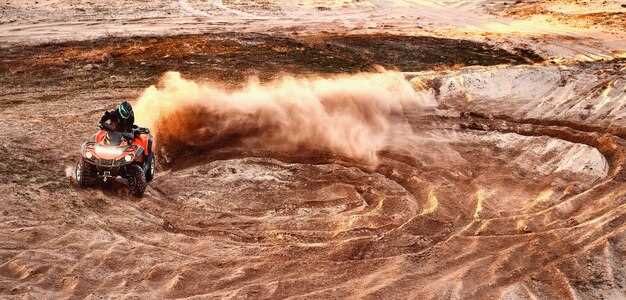
When it comes to off-road racing, understanding the nuances of track conditions is crucial for success. Different surfaces, such as mud and sand, present unique challenges that require specialized techniques and skills. Mastering these terrains not only improves performance but also enhances safety while navigating through unpredictable environments.
In muddy conditions, the surface can quickly become treacherous. Drivers must adapt their approach by refining their acceleration, braking, and cornering techniques to maintain control of their vehicle. Additionally, knowing when to shift weight and how to manage tire pressure can significantly affect traction on slippery tracks.
Conversely, racing on sandy terrain demands a different set of strategies. The loose nature of the surface requires drivers to maintain momentum and avoid abrupt movements that could lead to loss of control. Learning to read the undulations and selecting the right lines is essential for effective navigation through these shifting environments.
Optimizing Tire Selection and Pressure for Soft Terrain

Selecting the right tires for soft terrain is a critical strategy that can significantly enhance a vehicle’s performance on challenging tracks. When navigating mud or sand, wider tires often provide better flotation, preventing the vehicle from sinking. These tires typically feature more aggressive tread patterns, designed to grip uneven surfaces and maintain traction. It’s essential to consider the terrain’s characteristics, as different types of soft ground may require varying tire designs to ensure optimal handling.
Another vital aspect of strategy in soft terrain racing is adjusting tire pressure. Lowering the tire pressure increases the contact patch between the tire and the ground, allowing the vehicle to distribute its weight more evenly. This approach mitigates the risk of getting stuck and improves overall stability when cornering on loose surfaces. However, drivers must balance the benefits of lower pressure with the potential for increased tire wear and the risk of pinch flats, particularly on rocky tracks.
Experimenting with tire pressure can help find the ideal balance for specific conditions. A good practice is to start with a slightly lower pressure than usual and adjust based on performance feedback. Monitoring vehicle handling and grip will guide further adjustments. Proper tire selection and pressure optimization can turn a challenging race into a successful run, providing a competitive edge on soft terrain tracks.
Utilizing Throttle Control and Steering Techniques in Challenging Conditions

In competitive racing, particularly on unpredictable terrains like mud and sand, mastering throttle control and steering techniques is crucial for maintaining speed and stability. These elements become pivotal as drivers navigate the unique challenges presented by varying track conditions.
Throttle control is essential for managing wheel spin and traction loss. In muddy or sandy environments, excessive acceleration can lead to loss of grip, causing the vehicle to fishtail or get stuck. A careful and measured application of the throttle enables drivers to maintain forward momentum while minimizing slippage. Implementing a strategy that involves smooth and gradual throttle inputs rather than abrupt changes can help maintain traction on difficult surfaces.
Steering techniques also play a vital role in navigating challenging terrains. The precision of steering inputs can determine how effectively a vehicle responds to the terrain changes. In soft or loose conditions, it is beneficial to use gentle and gradual steering motions. This approach helps prevent the vehicle from losing control and allows for better tracking through turns, ensuring that the driver can follow the ideal racing line.
Combining throttle control with effective steering creates a cohesive strategy for traversing tricky tracks. Anticipating shifts in terrain and adjusting both throttle and steering accordingly can drastically improve performance. Practicing these techniques builds muscle memory, enabling more intuitive responses during races.
In conclusion, the ability to utilize throttle control and steering techniques effectively in muddy and sandy conditions sets skilled drivers apart. By understanding the specific demands of the terrain and adjusting their strategy, racers can enhance their performance and succeed in challenging environments.
Developing a Race Strategy Based on Terrain Analysis and Weather Conditions
Understanding the track’s surface is crucial for developing an effective race strategy, particularly in challenging environments like mud and sand. The characteristics of the terrain significantly influence vehicle performance, tire selection, and driving technique. Analyzing the surface allows drivers to anticipate grip levels, track irregularities, and potential hazards, enabling them to adapt their approach accordingly.
A thorough terrain analysis should include assessing the texture, moisture content, and overall composition of the surface. For instance, a muddy track may require deeper treads for enhanced traction, while a sandy surface might benefit from wider tires to prevent sinking. Additionally, understanding how different sections of the track vary can inform pit stop strategies, as certain areas may wear down tires faster than others.
Weather conditions are another vital factor in race planning. Rain can transform a dry, dusty track into a slippery challenge overnight, while heat can lead to drying out and developing ruts. Monitoring forecasts and current weather patterns allows drivers to prepare for changes that can affect the track’s surface. Adjusting tire pressure and suspension settings in response to weather conditions can also enhance vehicle stability and control.
Combining terrain analysis with weather assessments helps in formulating a comprehensive race strategy. For example, if a muddy surface is expected due to rain, drivers might choose more aggressive tire compounds and plan for increased pit stops to accommodate tire wear. Adapting driving techniques to match the conditions–such as using smoother throttle inputs in slick areas–can make a significant difference in overall performance.
Ultimately, a successful race strategy hinges on the ability to read the terrain and adapt to changing weather. Continuous practice, experience, and data analysis will enhance a driver’s ability to make real-time decisions and maintain an edge throughout the race.




